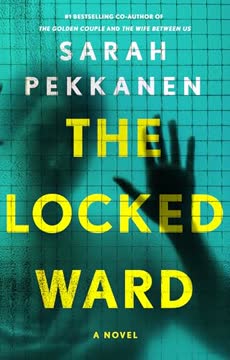Plot Summary
Desert Night, Hidden Tensions
In the remote luxury Ara hotel in Escalante, Utah, Frida and her brother Gabriel seek a rare reunion. The desert's silence is pierced by the tension between another couple: wealthy tabloid owner William Brenner and his much younger wife, Sabrina. Frida, ever vigilant and anxious from a traumatic past, observes their fraught dynamic, sensing danger beneath the surface. The hotel's design promises safety and isolation, but the guests' secrets and histories are anything but contained. As Frida smokes on the patio, she witnesses a violent argument between the Brenners, foreshadowing the violence to come. The desert night, with its deceptive calm, sets the stage for a story of trauma, suspicion, and the search for truth.
Sibling Reunion, Old Wounds
Frida and Gabriel, once inseparable, have drifted apart over the years, their bond frayed by distance and the scars of their cult upbringing. Their reunion at the Ara is prompted by a documentary about a past tragedy: the unsolved murder of Gabriel's wife, Annie. Both are haunted by their shared past and the unresolved pain of Annie's death, which cast suspicion on Gabriel and forced him into exile. Their attempts at reconnection are tentative, layered with unspoken grief, guilt, and the hope that this desert retreat might offer healing or at least understanding. But the past is never far, and the present soon demands their attention.
Cult Childhood, Émile's Test
Frida and Gabriel grew up in a cult led by the charismatic and manipulative Émile. Their world was one of deprivation, indoctrination, and constant surveillance. Émile's infamous "test"—a moral trap disguised as a choice between chicken or fish—instilled shame and obedience in the children, teaching them to distrust their own desires and to rely on Émile's guidance. The cult's rules erased family bonds, replacing them with loyalty to Émile and the collective. This upbringing left Frida and Gabriel with deep psychological wounds: anxiety, hypervigilance, and a desperate need for control and connection. Their shared trauma is both a bond and a barrier.
The Murder at Ara
The tranquility of the Ara is destroyed when Sabrina Brenner is found dead, her skull fractured, blood staining the desert stone. The guests are thrown into chaos, and suspicion immediately falls on William, whose public displays of anger and history of abuse make him the obvious suspect. Frida, who witnessed their argument, is compelled to speak to the police, but her own history with law enforcement—shaped by Gabriel's ordeal after Annie's death—makes her wary. The investigation is swift and clumsy, and the hotel's guests are left to grapple with fear, suspicion, and the knowledge that violence can erupt even in the most beautiful places.
The Husband Always Suspect
Gabriel's past as the prime suspect in his wife's unsolved murder haunts him. The narrative of "it's always the husband" is inescapable, both in the media and in the minds of those around him. As the investigation into Sabrina's death unfolds, Gabriel's proximity to the crime and his evasive behavior draw the attention of the police. Frida, desperate to protect her brother, is forced to confront the possibility that history may be repeating itself—and that the truth may be more complicated than she wants to believe.
The Weight of the Past
Frida's anxiety and compulsive need for control are rooted in her cult upbringing and the violence she witnessed and endured. Gabriel's migraines and depression are physical manifestations of his psychological scars. Both siblings have developed survival strategies—Frida through hypervigilance and workaholism, Gabriel through withdrawal and avoidance. Their relationship is defined by a pattern of mutual rescue and abandonment, shaped by the lessons of Émile's world: trust no one, expect betrayal, and do whatever it takes to survive.
Escape from Émile's World
As teenagers, Frida and Gabriel plotted their escape from the cult, aided by small acts of rebellion and the kindness of outsiders. Their flight was catalyzed by the revelation of Émile's sexual abuse of the girls, a secret kept by shame and enforced by the complicity of the adults. Their final act of defiance—a fire set in Émile's office—was both an attempt at justice and a desperate bid for freedom. The escape left them with guilt, especially over the unintended death of Edwina, a former friend turned enforcer. Their new life in the outside world was marked by poverty, struggle, and the constant fear of discovery.
The Investigation Tightens
The police investigation at the Ara intensifies. Frida and Gabriel are questioned, and their stories begin to diverge. Frida finds Sabrina's phone near a coyote den, planted there by someone with knowledge of her habits. The phone contains Gabriel's name, birthdate, and address, raising further suspicion. Meanwhile, a bloodstained rock—the murder weapon—is discovered in Gabriel's backpack, seemingly damning evidence. Frida realizes they are being framed, but by whom? The siblings' trust in each other is tested as the pressure mounts and the possibility of betrayal looms.
Secrets, Lies, and Alibis
As the investigation unfolds, secrets and lies multiply. Gabriel confesses to an affair with Sabrina, explaining his evasive behavior and the presence of her hair clip in his belongings. Frida, desperate to protect him, considers lying to the police but is torn by her own moral code and the weight of past deceptions. The true killer manipulates evidence and perception, exploiting the siblings' vulnerabilities and the police's eagerness for a quick resolution. The line between guilt and innocence blurs, and the siblings must decide how much they are willing to sacrifice for each other.
The Butterfly Hair Clip
Sabrina's butterfly hair clip, found in Gabriel's backpack, becomes a symbol of intimacy, guilt, and the power of small details to unravel lives. Its presence is both innocent—a token from a brief affair—and incriminating, used to cast suspicion on Gabriel. The clip's journey mirrors the siblings' own: a cherished object, hidden and revealed, carrying the weight of memory and the threat of exposure. It is a reminder that the truth is often found in the smallest things.
The True Killer's Trap
Frida pieces together the true sequence of events: William, enraged by his wife's infidelity, killed Sabrina in a fit of violence. He then orchestrated an elaborate frame-up, planting evidence to implicate Gabriel and manipulating Frida into delivering key items to the police. William's power, wealth, and understanding of media narratives allow him to control the story—until Frida, drawing on her own experience with crime and survival, uncovers the hidden evidence in William's rental car. The trap is sprung, but not on the intended victim.
Confessions and Consequences
With the evidence in hand, Frida confronts the police and secures Gabriel's release. William is arrested, his guilt undeniable. In the aftermath, Frida confesses her own darkest secret to Gabriel: she killed Annie, his wife, years ago, to protect them both from exposure for the cult fire and Edwina's death. The revelation devastates Gabriel, who banishes Frida from his life. The siblings are forced to reckon with the consequences of their actions, the limits of forgiveness, and the cost of survival.
The Fire and the Aftermath
The fire that destroyed Émile's office was both an act of liberation and a source of lifelong guilt. The unintended death of Edwina haunts Frida and Gabriel, shaping their sense of self and their relationship to violence. The aftermath of the fire—homelessness, struggle, and eventual reinvention—demonstrates the resilience of the human spirit but also the enduring power of trauma. The siblings' journey from cult victims to survivors is marked by both triumph and tragedy.
Annie's Death, Frida's Guilt
Annie's death was not the random tragedy the world believed, nor the crime for which Gabriel was blamed. It was Frida's desperate act to protect their secret and their future. The murder was meticulously planned and executed, but its psychological toll was immense. Frida's guilt manifests as insomnia, anxiety, and a compulsion to control her environment. Her confession to Gabriel is both a plea for absolution and an acknowledgment that some wounds never heal.
The Power of Survival
Frida and Gabriel's survival is a testament to their adaptability and determination. They navigate the challenges of the outside world—poverty, bureaucracy, and the search for identity—with ingenuity and grit. Their ability to reinvent themselves is both a strength and a source of alienation, as they struggle to form connections and trust others. The cost of survival is high: the loss of innocence, the burden of secrets, and the constant threat of exposure.
The Final Confrontation
The final confrontation at the Ara brings all the story's threads together: the legacy of the cult, the trauma of violence, the complexity of love and loyalty. Frida's actions save Gabriel, but at the cost of their relationship. The truth, once revealed, cannot be undone. Justice is served, but it is imperfect and incomplete. The siblings must decide whether to seek forgiveness, to confess, or to continue living with the consequences of their choices.
Love, Loyalty, and Loss
The story's heart is the bond between Frida and Gabriel: forged in trauma, tested by betrayal, and ultimately remade through honesty and sacrifice. Their relationship is a study in the complexities of love—familial, romantic, and selfless. The narrative explores the limits of loyalty, the pain of loss, and the possibility of redemption. In the end, love is both the source of their suffering and the key to their survival.
Family, Forgiveness, and Truth
In the aftermath, Frida and Gabriel attempt to rebuild their lives. Gabriel returns to New York, and the siblings agree to participate in the documentary that first brought them together. Their story is one of survival, but also of the enduring power of the past. Forgiveness is possible, but it is hard-won and incomplete. The truth, once revealed, offers both liberation and new burdens. The siblings' journey is ongoing, shaped by the lessons of their childhood and the choices they have made.
Characters
Frida Nilsen
Frida is the novel's narrator and emotional core, shaped by a childhood in a cult and a lifetime of trauma. Hypervigilant, anxious, and fiercely intelligent, she is both Gabriel's protector and his greatest threat. Her need for control and safety is a response to years of deprivation and abuse. Frida's greatest secret—her murder of Annie to protect herself and Gabriel—defines her adult life, fueling her guilt and insomnia. Her relationship with Gabriel is complex: sibling, co-conspirator, and, ultimately, confessor. Frida's journey is one of survival at any cost, but also of reckoning with the moral consequences of her actions.
Gabriel Miller
Gabriel is Frida's "brother" in everything but blood, bound to her by their shared cult upbringing and mutual trauma. Sensitive, intelligent, and prone to depression, Gabriel is both a victim and a survivor. His life is marked by loss: the cult, his wife Annie, and his own sense of innocence. Wrongly accused of Annie's murder, he flees to Seattle, seeking anonymity and peace. His affair with Sabrina is a brief, doomed attempt at connection. Gabriel's greatest struggle is with guilt—over his failures, his inability to save others, and his dependence on Frida. His capacity for forgiveness is tested to its limits.
Émile Blanchard
Émile is the architect of Frida and Gabriel's trauma. A master of psychological control, he creates a world in which children are isolated, indoctrinated, and made to feel inherently dangerous. His "tests" and sermons instill shame and obedience, while his sexual abuse of the girls is an open secret, enforced by the complicity of the adults. Émile's power is both personal and systemic, shaping the siblings' understanding of love, trust, and authority. His eventual downfall is both a victory and a source of enduring guilt for his former followers.
Annie Woodward
Annie is Gabriel's wife and Frida's friend, a symbol of the normal life both siblings crave but cannot attain. Intelligent, privileged, and well-meaning, Annie is ultimately undone by her proximity to the siblings' secrets. Her death—at Frida's hands, though the world blames Gabriel—serves as the novel's central mystery and moral fulcrum. Annie's presence lingers as a ghost, a reminder of what might have been and the cost of survival.
William Brenner
William is the wealthy, powerful tabloid owner whose violence and cunning drive the novel's central crime. His abuse of Sabrina is both physical and psychological, and his ability to manipulate evidence and perception makes him a formidable antagonist. William's framing of Gabriel is a masterclass in misdirection, exploiting the biases of the police and the media. His eventual downfall is a rare moment of justice in a world where power often protects the guilty.
Sabrina Brenner
Sabrina is William's much younger wife, trapped in a cycle of abuse and longing for freedom. Her brief affair with Gabriel is an act of agency, a desperate attempt to reclaim control over her life. Sabrina's death is the catalyst for the novel's events, and her memory haunts both Gabriel and Frida. She is both a symbol of vulnerability and a reminder of the dangers faced by women in abusive relationships.
Edwina
Edwina is a former friend of Frida's, elevated to a position of power within the cult as an enforcer of Émile's rules. Her complicity in the abuse of other girls is both a survival strategy and a source of guilt. Edwina's death in the fire set by Frida and Gabriel is an unintended consequence that haunts them both, a symbol of the collateral damage of resistance.
Deputy Harris
Harris is the young police deputy leading the investigation into Sabrina's death. Eager for a quick resolution and susceptible to the narratives presented by William and others, Harris is both a threat and a pawn. His pursuit of Gabriel is driven by bias and a desire for recognition, but he is ultimately outmaneuvered by Frida's resourcefulness.
Catalina
Catalina is the manager of the Ara, responsible for maintaining the illusion of safety and luxury. Her role is largely passive, but she represents the world's tendency to look away from violence and discomfort, prioritizing appearances over truth.
Joan
Joan is a bartender in the nearby town who shows kindness to Frida and Gabriel during their early escapes from the cult. Her generosity is a rare beacon of hope, teaching the siblings that the outside world can offer compassion. Joan's later fate—a victim of violence herself—underscores the novel's themes of vulnerability and the randomness of survival.
Plot Devices
Dual Timelines and Interwoven Narratives
The novel alternates between the present-day murder investigation at the Ara and the siblings' past in the cult, their escape, and the aftermath. This structure allows the reader to see how past traumas shape present actions, and how secrets and guilt accumulate over time. The gradual revelation of key events—Émile's abuse, the fire, Annie's death—mirrors the unfolding of the central mystery, creating suspense and deepening the psychological complexity.
Unreliable Narration and Withheld Information
Frida's narration is marked by anxiety, self-doubt, and selective disclosure. She withholds key information—from the police, from Gabriel, and from the reader—mirroring the ways in which trauma survivors compartmentalize and rationalize their actions. The novel's suspense is driven by the gradual unspooling of these secrets, culminating in Frida's confession and the revelation of the true killer.
Symbolism of Objects
Objects like Sabrina's butterfly hair clip, the bloodstained rock, and the dollar bill with lipstick serve as symbols of intimacy, guilt, and the persistence of the past. These items are both evidence in the literal sense and metaphors for the ways in which small details can unravel or preserve lives.
The "Always the Husband" Trope
The novel plays with the familiar narrative that the husband is always the prime suspect in a woman's death. By making Gabriel both a victim of this trope and a red herring, the story critiques the limitations of such assumptions while acknowledging their basis in reality. The real killer is another husband, hiding in plain sight.
Trauma as Character and Plot Engine
The psychological scars of cult life, abuse, and violence are not just backstory—they drive every decision the characters make. Frida's compulsions, Gabriel's avoidance, and their mutual inability to trust are both obstacles and tools in their quest for survival and justice.
Analysis
Our Last Resort is a masterful psychological thriller that explores the long shadow of trauma, the complexity of survival, and the moral ambiguity of justice. Through its dual timelines and deeply flawed, compelling characters, the novel interrogates the narratives we tell about crime, family, and redemption. It subverts "the husband did it" trope by making the obvious suspect both a victim and a red herring, while exposing the real dangers of power, abuse, and complicity. The story's heart is the bond between Frida and Gabriel: forged in suffering, tested by betrayal, and ultimately remade through honesty and sacrifice. The novel asks whether it is possible to escape the past, to forgive the unforgivable, and to build a life on the ashes of destruction. In a world where survival often demands moral compromise, Our Last Resort offers a nuanced meditation on the costs and possibilities of love, loyalty, and truth.
Last updated:
Review Summary
Our Last Resort receives mixed reviews, with an average rating of 3.52 out of 5. Readers praise the atmospheric writing, complex characters, and intriguing cult backstory. Many find the dual timeline structure effective, though some feel the pacing is slow. The mystery and suspense elements are generally well-received, but a few readers find the plot predictable. Most agree it's an engaging read, albeit not as impactful as Michallon's debut novel. The exploration of trauma, family bonds, and the lasting effects of cult indoctrination are highlighted as strengths.
Similar Books
Download PDF
Download EPUB
.epub digital book format is ideal for reading ebooks on phones, tablets, and e-readers.












